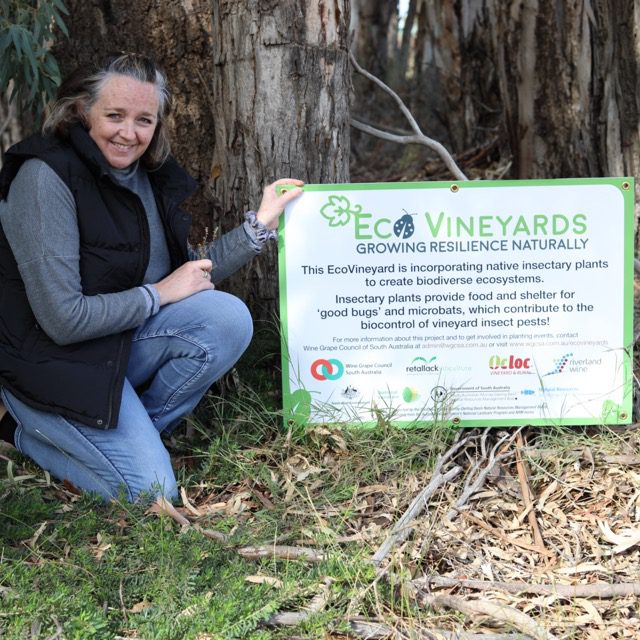1. Tell us about your experience in grape growing?
I have been managing my family’s vineyard with my husband Craig for around 15 years. Before that, I worked as a Viticulturist specialising in the area of Integrated Pest and Disease Management. I also have a degree in Natural Resource Management from Roseworthy.
2. What prompted you to want to be involved in the EcoVineyards project?
We are very passionate about the role that native vegetation and beneficial insects can play in wine grape growing. We grow over 320 ha of vineyard and orchard plantings in the Riverland. Breaking down the monoculture is a challenge but we’re finding it can be achieved without compromising yield or quality.
3. What do you hope to achieve from your involvement in the EcoVineyards project?
This project gives us an opportunity to improve biodiversity in the vineyard, observe the presence of beneficial insects and the potential to implement an integrated pest and disease program. By using native vegetation and insect populations endemic to our region, we hope to work towards a ‘whole of vineyard’ approach. This will complement traditional vineyard management rather than seeing the surrounding environment as a separate and stand-alone aspect of wine grape growing.
4. Have you tried to increase biodiversity on your property before undertaking this project? If so, how?
Our family and subsequently our vineyards are very active in the local natural resources management community. We are founding members of the Yatco Wetland Landcare Group. In partnership with State Government, we completed a significant wetland management and irrigation infrastructure project which not only resulted in improved ability to manage water in the wetland and river floodplain but also improved irrigation management capacity for the surrounding growers.
This project is a great example of what can be achieved when government works alongside the people that manage natural resources. We have also recognised the value of remnant mallee vegetation on our properties through formal Heritage Agreements and the removed grazing from river floodplain areas.
5. Why do you think it is so important for growers to try and build natural resilience on their property?
The bottom line is that building natural resilience should improve profitability over time. The benefits of environmental stewardship, adapting to a changing climate and long term sustainability are all obvious and any wine grape grower who has experienced drought, hail and bushfire is aware of this. The real driver for a project like this will be meeting yield and quality objectives and achieving cost of production savings. Projects like EcoVineyards help break a big issue into smaller, more achievable goals and may ultimately dispel some of the myths around being ‘green’ eating into profit.
6. Looking to the future, what do you see as a new ‘normal’ for grape growers on their properties?
I actually don’t think there will be a new normal. The key to using biodiversity as part of your production system is taking what you already have and enhancing it. This will be different for each wine grape grower depending on their vineyard location, natural assets and cultural management aims and capabilities. The wine industry by default is made up of very different growing regions, vineyard enterprises and wine products. Using the natural attributes in our business to improve the end product and further promote a ‘clean and green’ image is nothing new but that doesn’t mean that we can’t get better at it.
READ THE CASE STUDY

